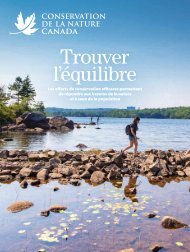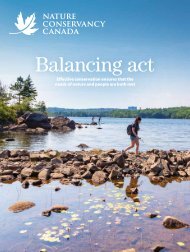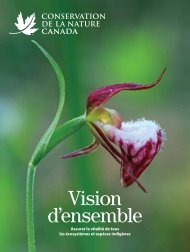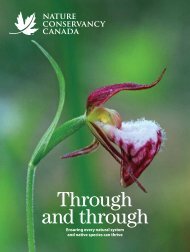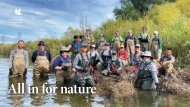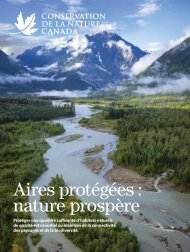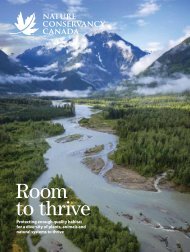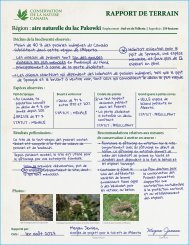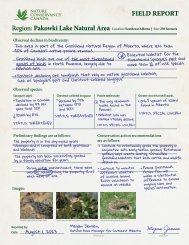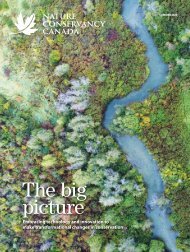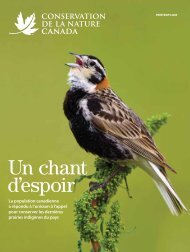NCC Magazine Spring 2023
Create successful ePaper yourself
Turn your PDF publications into a flip-book with our unique Google optimized e-Paper software.
SPRING <strong>2023</strong><br />
Songs<br />
of<br />
hope<br />
A chorus of<br />
Canadians has<br />
joined the call<br />
to conserve<br />
our remaining<br />
native prairie<br />
grasslands
SPRING <strong>2023</strong><br />
CONTENTS<br />
Nature Conservancy of Canada<br />
4 Our aim is true<br />
The power of partnership is essential to<br />
hitting Canada’s conservation targets.<br />
6 Dutch Creek Hoodoos<br />
These hoodoos in BC’s Columbia<br />
Valley offer a stunning view over<br />
an important wildlife corridor.<br />
7 Build a bee garden<br />
Four tips to help bees.<br />
7 Ripple effects<br />
For Catherine Stewart, Canada’s<br />
Ambassador for Climate Change,<br />
water nourishes mind and body.<br />
8 A gift for the Prairies<br />
The Weston Family Prairie Grasslands<br />
Initiative is empowering ranchers to<br />
conserve native prairie habitat.<br />
12 All smiles<br />
Keep your eyes open for the<br />
“smiling” Blanding’s turtle.<br />
14 Telling it like it is<br />
Aerin Jacob, <strong>NCC</strong>’s director of<br />
conservation science and research,<br />
on big thinking and genuine<br />
communication in conservation.<br />
16 Project updates<br />
Expanding protection on The<br />
Rock; ensuring a tall grass legacy;<br />
conservation, education and<br />
science unite; receiving high honours.<br />
18 A dance to remember<br />
Brian Keating on the spellbinding<br />
dance of the sharp-tailed grouse.<br />
Digital extras<br />
Check out our online magazine page with<br />
additional content to supplement this issue,<br />
at nccmagazine.ca.<br />
Nature Conservancy of Canada<br />
245 Eglinton Ave. East, Suite 410 | Toronto, Ontario, Canada M4P 3J1<br />
magazine@natureconservancy.ca | Phone: 416.932.3202 | Toll-free: 877.231.3552<br />
The Nature Conservancy of Canada (<strong>NCC</strong>) is the country’s unifying force for nature. We seek<br />
solutions to the twin crises of rapid biodiversity loss and climate change through large-scale,<br />
permanent land conservation. <strong>NCC</strong> is a registered charity. With nature, we build a thriving world.<br />
The Nature Conservancy of Canada <strong>Magazine</strong> is distributed to donors and supporters of <strong>NCC</strong>.<br />
TM<br />
Trademarks owned by the Nature Conservancy of Canada.<br />
FSC is not responsible for any calculations on<br />
saving resources by choosing this paper.<br />
Printed on Enviro100 paper, which contains 100% post-consumer fibre, is EcoLogo, Processed Chlorine Free<br />
certified and manufactured in Canada by Rolland using biogas energy. Printed in Canada with vegetable-based<br />
inks by Warrens Waterless Printing. This publication saved 183 trees and 60,762 litres of water*.<br />
TKTKTKTKTKTKT<br />
GENERATED BY: CALCULATEUR.ROLLANDINC.COM. PHOTO: LETA PEZDERIC. COVER: DAVID SEIBEL.<br />
*<br />
2 FALL 2022 natureconservancy.ca
McIntyre Ranch, Alberta.<br />
Featured<br />
Contributors<br />
Dear friends,<br />
KEVIN TKTKTKTKTKTKT<br />
TENEYCKE: BRIAN YUNGBLUT PHOTOGRAPHY. ALBERT LAW: SACHIN KHONA. JULIE BARNES: MATT RAMAGE/STUDIO D.<br />
Ihave been privileged to experience our country’s vast and<br />
open grasslands — seas of gold and green, where blades of<br />
grass sway in the gentle breeze. Prairie wildflowers add pops<br />
of colour to the rolling plains. The wafts of fragrant prairie sage<br />
make you feel that this is the world’s biggest herb garden. These<br />
are my favourite things about the Canadian prairies, which both<br />
captivate and sustain. I have experienced this amazing landscape<br />
and my children have, too, but I worry that their children may<br />
never experience these same opportunities.<br />
In my 20 years of delivering conservation programming, I’ve<br />
seen a wave of change — even in just the last decade — that has<br />
enabled us to work toward innovative solutions that are compatible<br />
with conservation and livestock producers.<br />
When conservation groups collaborate with donors and supporters,<br />
we can provide ranchers with the financial resources to do<br />
things that increase the quality of grasslands, like rotational grazing.<br />
Meaningful changes like these take a whole-of-society approach<br />
to conservation.<br />
In this issue’s feature story, you’ll read about the Stewardship<br />
Investment Program, funded through the Weston Family Prairie<br />
Grasslands Initiative — the largest ever private investment in<br />
conserving Canada’s grasslands. This program is a great example<br />
of society’s collective effort to protect habitat and the species<br />
that depend on them.<br />
At the Nature Conservancy of Canada, we take to heart the<br />
belief that when nature thrives, people thrive. With the arrival<br />
of warmer weather, I invite you to reconnect with a part of nature<br />
that you love, learn about Canada’s grasslands and how you can<br />
lend a helping hand.<br />
Yours in conservation,<br />
Kevin Teneycke<br />
Kevin Teneycke<br />
Regional Vice President – Manitoba<br />
Julie Barnes is a<br />
freelance writer based<br />
in Saskatoon. She has<br />
written about travel,<br />
gardening, architecture,<br />
residential construction,<br />
food and agriculture,<br />
urban planning, cottage<br />
communities and<br />
education for a variety<br />
of publications and<br />
industry clients. She<br />
wrote “A gift for the<br />
grasslands,” page 8.<br />
Albert Law is a<br />
Vancouver-based<br />
editorial and commercial<br />
photographer.<br />
His work spans<br />
a broad range, from<br />
soft editorial portraits<br />
to photojournalism<br />
in austere conditions<br />
with the Canadian<br />
Armed Forces. He<br />
photographed Aerin<br />
Jacob for “Telling it<br />
like it is,” on page 14.<br />
natureconservancy.ca<br />
SPRING <strong>2023</strong> 3
COAST TO<br />
COAST<br />
2<br />
Our<br />
aim<br />
is true<br />
Extending support for Canada’s natural areas<br />
1<br />
3<br />
4<br />
Over the next three years, the Nature<br />
Conservancy of Canada (<strong>NCC</strong>) will<br />
conserve an additional 130,000 hectares<br />
of priority natural habitat, thanks to the<br />
extension of the Natural Heritage Conservation<br />
Program (NHCP). With this support,<br />
along with matching funds from our partners<br />
and donors, <strong>NCC</strong>’s commitment will result<br />
in the protection of natural areas spanning<br />
roughly three times the size of Montreal. Since<br />
2007, the NHCP has matched more than<br />
$445 million in investment from the Government<br />
of Canada, with more than $875 million<br />
in non-federal funding to delivere more than<br />
$1.3 billion in conservation outcomes.<br />
The NHCP is designed to bring partners<br />
together to unlock conservation solutions.<br />
Working alongside other program partners,<br />
including Ducks Unlimited Canada, Wildlife<br />
Habitat Canada and the country’s land<br />
trusts, <strong>NCC</strong> will build upon the success of<br />
the program.<br />
The extended NHCP will help <strong>NCC</strong> find<br />
new and innovative ways to conserve more<br />
lands faster, including privately protected<br />
areas, publicly protected areas and conservation<br />
on working landscapes. <strong>NCC</strong> will also<br />
continue to support and advance Indigenous-led<br />
conservation, including Indigenous<br />
Protected and Conserved Areas.<br />
Lands protected and cared for by <strong>NCC</strong><br />
under the NHCP will provide benefits<br />
for species at risk and migratory birds, and<br />
ensure the health and connectedness of<br />
natural systems. They will provide opportunities<br />
for climate change mitigation and<br />
VIEW OUR SUCCESSES<br />
SINCE THE START OF THE<br />
NATURAL HERITAGE<br />
CONSERVATION PROGRAM<br />
adaptation, and maintain ecosystem services<br />
for neighbouring communities.<br />
These projects have the potential to<br />
capture at least 250,000 tonnes of carbon<br />
over the three-year term of the program<br />
extension, equivalent to taking 52,000 passenger<br />
vehicles off the road<br />
While much has been accomplished<br />
through this partnership, the urgency of the<br />
biodiversity and climate change crises demand<br />
that we do more to ensure a thriving<br />
world for nature and people.1<br />
LEFT TO RIGHT: CARYS RICHARDS; STEVE OGLE; JASON BANTLE; <strong>NCC</strong>.<br />
4 WINTER SPRING <strong>2023</strong> natureconservancy.ca
HITTING THE MARK<br />
Contributions from the NHCP since 2007 have helped accomplish:<br />
90,000<br />
The total number of hectares of grasslands protected under<br />
the program, an area larger than the city of Calgary.<br />
480,000<br />
The total number of hectares of forested habitat conserved,<br />
an area three times larger than Gros Morne National Park.<br />
300,000<br />
The total number of hectares supported by stewardship activities.<br />
96<br />
The percentage of all NHCP properties within 25 kilometres<br />
of provincially or nationally protected areas, contributing to<br />
connectivity in these areas.<br />
10<br />
5<br />
8<br />
7<br />
9<br />
6<br />
LEFT TO RIGHT: ANDREW WARREN; KENAUK NATURE; MIKE DEMBECK;<br />
DENIS DUQUETTE; IRWIN BARRETT; ANDREW HERYGERS/<strong>NCC</strong> STAFF.<br />
Key projects since 2007<br />
1. Darkwoods Conservation Area, BC<br />
Valleys, mountains, lake<br />
2. Birch River Wildland Provincial Park, AB<br />
Boreal forest<br />
3. Buffalo Pound, SK<br />
Native grasslands<br />
4. Douglas Marsh, MB<br />
Marsh wetlands, native upland prairie<br />
5. Boreal Wildlands, ON<br />
Boreal forest, rivers, streams<br />
6. Kenauk, QC<br />
Old-growth forests, wetlands, lakes<br />
7. Musquash Estuary Nature Reserve, NB<br />
Acadian forest, marshes<br />
8. Conway and Cascumpec<br />
Sandhills Nature Reserve, PE<br />
Sand dunes, wetlands<br />
9. Shaw Wilderness Park, NS<br />
Temperate forest, marshes<br />
10. Grand Codroy Estuary Nature Reserve, NL<br />
Boreal forest, marshes, wetlands<br />
natureconservancy.ca<br />
SPRING <strong>2023</strong> 5
BOOTS ON<br />
THE TRAIL<br />
<br />
N<br />
Westside Road<br />
Dutch Creek<br />
Hoodoos<br />
Formed over thousands of years,<br />
these hoodoos offer a stunning view<br />
over an important wildlife corridor<br />
Dutch Creek<br />
Hoodoos<br />
Conservation<br />
Area<br />
The Hoodoos<br />
Dutch Creek<br />
The craggy spires and rugged cliffs of<br />
the Dutch Creek Hoodoos Conservation<br />
Area are a sight to behold. Looking<br />
much like a child’s sandcastle, the hoodoos<br />
formed over thousands of years of glaciation<br />
and erosion. The cliffs sit at the north end<br />
of Columbia Lake, in BC’s Rocky Mountain<br />
Trench in the territory of the Ktunaxa Nation<br />
and the Secwépemc (Shuswap Band). The<br />
trench is immensely important as a wildlife<br />
corridor. The Douglas-fir forest on the<br />
benchlands above the hoodoos provides<br />
prime habitat for many wildlife species,<br />
including mule deer and elk. The hoodoos<br />
themselves harbour precariously placed nests<br />
for white-throated swifts and violet-green<br />
swallows, while raptors circle on the updrafts<br />
looking for prey.<br />
The conservation area is a popular walking<br />
spot for locals and visitors alike. A wellgroomed<br />
trail leads through the forest to the<br />
bench above the hoodoos. From the top of the<br />
cliffs, visitors are treated to a stunning panoramic<br />
view of Columbia Lake and beyond.1<br />
LEGEND<br />
-- Dutch Creek Hoodoos Trail<br />
P Parking<br />
SPECIES TO SPOT<br />
• American badger<br />
• black bear<br />
• elk<br />
• golden eagle<br />
• mule deer<br />
• sharp-shinned hawk<br />
• violet-green swallow<br />
• white-throated swift<br />
LEARN MORE<br />
natureconservancy.ca/dutchcreek<br />
MAP: JACQUES PERRAULT. PHOTOS TOP TO BOTTOM: STEVE OGLE;<br />
STEVE OGLE; ALAMY STOCK PHOTO; STEVE OGLE; <strong>NCC</strong>.<br />
6 SPRING <strong>2023</strong><br />
natureconservancy.ca
ACTIVITY<br />
CORNER<br />
BACKPACK<br />
ESSENTIALS<br />
Tips for a<br />
bee garden<br />
Four tips to help bees<br />
<strong>Spring</strong> has sprung, and the warming weather and<br />
thawing ground may just be the motivation you need<br />
for some yard improvements this year. While you’re<br />
getting your hands dirty, we invite you to take stock<br />
of what you can do to support bees. Native bees are<br />
best adapted to native plants, which often require<br />
less maintenance from us than ornamental varieties,<br />
and provide a higher quality food source for the bees.<br />
You don’t need an overhaul right away; you can make<br />
an impact by adding one or two native species a year.<br />
Here are a few tips for designing a bee garden:<br />
ILLUSTRATION: CORY PROULX. PHOTO: DOMINIC STEINMANN.<br />
1. CHOOSE PLANTS<br />
NATIVE TO YOUR<br />
REGION<br />
Refer to online sources,<br />
a plant guidebook<br />
for your region, or<br />
consult your local plant<br />
nursery for recommendations<br />
on bee-friendly<br />
plants that are native<br />
to your area. Planting<br />
a number of different<br />
species can provide<br />
nectar and pollen as<br />
food from spring to<br />
fall. Help foraging bees<br />
by providing their<br />
favourite plants in<br />
big patches.<br />
2. CREATE HABITAT<br />
FOR BEES<br />
Grow plants with<br />
hollow stems for<br />
cavity-nesting bees,<br />
like mason bees and<br />
carpenter bees. Come<br />
fall, leave any fallen<br />
plant material for bees<br />
and other pollinators<br />
to dwell in over winter.<br />
3. DESIGNATE A<br />
SUNSHINE SPOT<br />
Ground-nesting bees,<br />
such a sweat bees and<br />
mining bees, need loose<br />
and sparsely vegetated<br />
soil in a sunny location.<br />
Provide a patch of bare,<br />
dry and well-drained soil<br />
in a warm spot.<br />
4. ADD A PLACE TO<br />
QUENCH THIRST<br />
Provide a shallow dish of<br />
fresh, clean water, with<br />
partially submerged<br />
rocks as platforms for<br />
bees and other<br />
pollinators.1<br />
LEARN MORE<br />
Ripple effects<br />
For Catherine Stewart, Canada’s Ambassador for Climate<br />
Change, water nourishes mind and body<br />
Water has always been a big part of my life. Growing up on Lake Ontario,<br />
and later Rice Lake near Cobourg, Ontario, my early years spent lakeside<br />
gave me a deep appreciation for time spent in nature.<br />
At 17, I worked as an Ontario Junior Ranger, helping to maintain and clean Ontario<br />
provincial parks. It was a chance to connect with youth from across the province, and<br />
our conversations were deep and meaningful in those expansive landscapes. After<br />
a long day of canoeing, we would dip our standard-issue hard hats into the lake and<br />
enjoy a refreshing drink.<br />
Today, I’m rarely found without my stainless-steel water bottle in my backpack.<br />
Whether in nature or travelling through an airport, it’s an essential. I find sentimental<br />
value in my trusted companion of years, and each time I use it I know it’s one less<br />
plastic water bottle.<br />
To me, summers in Canada are about hearing crickets and loon calls on the water<br />
under the stars. In winter, there’s nothing like being carried by the wind while skating<br />
on a frozen lake. I always appreciate a short walk or a long trip, to connect more<br />
closely with others, and myself, in the outdoors. The magic of nature is that it can be<br />
felt by all.1<br />
natureconservancy.ca<br />
SPRING <strong>2023</strong> 7
A<br />
gift<br />
for the<br />
grasslands<br />
The Weston Family Prairie<br />
Grasslands Initiative is<br />
empowering ranchers to play<br />
a critical role in conserving<br />
the few native prairie grasslands<br />
we have left<br />
BY Julie Barnes, freelance writer and editor<br />
Tamara Carter takes<br />
stock of the cattle<br />
on her family ranch.<br />
RACHELLE HODGINS.<br />
8 SPRING <strong>2023</strong> natureconservancy.ca
It’s a crisp, early December<br />
afternoon when I approach the<br />
Carter family ranch in southwest<br />
Saskatchewan. At first glance, it’s<br />
a stark winter landscape, capped<br />
in a blanket of fresh snow, disturbed only<br />
by the tracks of a Nuttall’s cottontail rabbit.<br />
But spend a little time here, and it becomes<br />
clear that these lands are brimming<br />
with biodiversity, both above and below the<br />
mineral-rich soil. And the Carters are intent<br />
on keeping it that way.<br />
Three kilometres down the driveway,<br />
some of the Carters’ 250 black Angus cattle<br />
come into view; a dramatic contrast against<br />
the white backdrop. Just up ahead is the<br />
family homestead, perched on the crest of a<br />
hill, shrouded in majestic stands of towering<br />
conifers, green ash and box elder.<br />
Tamara and Russ Carter are the stewards<br />
of these 2,800 hectares of native prairie grasslands.<br />
They purchased the land in 1996 and<br />
raised their children here, but the Carters’<br />
roots run even deeper. Russ’ family has farmed<br />
and ranched on these lands for over 100 years.<br />
Here, an interconnected web of soil microbiota,<br />
insects, plants, wildlife, cattle and humans<br />
work in harmony to maintain healthy<br />
and resilient grassland ecosystems. “It’s a gift,<br />
and it is a privilege,” says Tamara. “There’s<br />
a tremendous responsibility to care for the<br />
land. I don’t take it lightly.”<br />
Grasslands are among the world’s most<br />
endangered — and least protected — ecosystems.<br />
By some estimations, more than<br />
75 per cent of Canada’s prairie grasslands<br />
have been eradicated. Cropland conversion,<br />
urban sprawl and infrastructure, like highways,<br />
all play a role in their decline. Temperate grasslands<br />
are like giant lungs,” Tamara says. “They<br />
clean the air. They filter water.” She adds that<br />
the roots of the native grasses can reach down<br />
many metres, aiding in carbon sequestration.<br />
“People across Canada benefit from the positive<br />
impact of healthy and intact grasslands.”<br />
It’s Tamara’s “boots-on-the-ground” experience<br />
as a rancher that made her ideally<br />
suited to take on the role of director of prairie<br />
grasslands conservation for the Nature<br />
Conservancy of Canada (<strong>NCC</strong>) for the last<br />
two years to develop and lead the Weston<br />
Family Prairie Grasslands Initiative (WFPGI),<br />
the largest ever prairie investment in stewardship<br />
on Canada’s grasslands. Although<br />
Tamara will be handing off the project, she<br />
has set it up well for success.<br />
Launched in 2021, the Stewardship Investment<br />
Program (SIP) is a four-year collaboration<br />
funded through the WFPGI. The SIP is<br />
designed to protect and conserve native prairie<br />
grasslands in Alberta, Saskatchewan and<br />
Manitoba. <strong>NCC</strong> has partnered with four land<br />
trusts to expand the program’s reach and<br />
amplify the impact: Ducks Unlimited Canada,<br />
Manitoba Habitat Heritage Corporation,<br />
Southern Alberta Land Trust Society<br />
(SALTS) and Western Sky Land Trust.<br />
Together with these land trusts, <strong>NCC</strong> is<br />
providing up to 830 grants. The funding aims<br />
to support work to maintain and enhance biodiversity<br />
outcomes on as much as 1.4 million<br />
hectares of grasslands in the Prairie provinces.<br />
natureconservancy.ca<br />
SPRING <strong>2023</strong> 9
All this is thanks to the generosity of the Weston<br />
Family Foundation’s healthy landscapes<br />
portfolio, which aims to restore and protect<br />
biodiversity on Canada’s wild, agricultural and<br />
urban landscapes. Landowners who meet the<br />
eligibility requirements can apply for an <strong>NCC</strong><br />
grant of up to $10,000 to fund projects that<br />
protect their grasslands and the species that<br />
depend on them.<br />
The funding comes at an opportune time,<br />
as ranchers are under increased financial<br />
pressure due to rapidly rising costs of fertilizer,<br />
fuel, feed and machinery. “Everything<br />
is going up, except what we’re getting paid<br />
for our cattle. Retail prices are not at all representative<br />
of what the rancher gets paid.”<br />
Landowners can make more money converting<br />
their grasslands into cropland for<br />
growing high-value crops like canola, wheat<br />
or lentils. “It’s really tempting if you’re not<br />
making money with cattle,” explains Tamara.<br />
Much of the country’s remaining grasslands<br />
are managed or owned by cattle producers,<br />
so ranchers like Tamara play a critical role in<br />
their stewardship. As the administrator of<br />
the SIP, she acted as a conduit between the<br />
conservation and ranching communities.<br />
“I learned about conservation myself from<br />
<strong>NCC</strong>, and now I’m taking some of that learning<br />
back into the ranching communities<br />
and saying, ‘Hey — this is what you can do<br />
with a partnership with <strong>NCC</strong>.’”<br />
As of year two, the program has funded<br />
close to 330 projects. The development of<br />
water systems and wildlife-friendly fencing<br />
have been among the most popular projects<br />
initiated by grant recipients, says Tamara.<br />
Ranchers and their herds play a critical role in the stewardship of Canada’s remaining grasslands.<br />
Wells of conservation<br />
The Prairies have experienced five years of<br />
significant drought, and Tamara has met with<br />
ranchers who were considering downsizing<br />
their herd and have even exited the industry<br />
due to lack of water access. The program has<br />
helped grant recipients finance the installation<br />
of new wells and troughs, allowing ranchers to<br />
keep their herd intact. “Those projects have<br />
instant, measurable results,” Tamara says.<br />
Cecily and Brian Knodel have witnessed<br />
the immediate impact a new water source can<br />
provide. Their family has been ranching on<br />
the northern slopes of Cypress Hills, Alberta,<br />
for over 120 years. During their lifetime, the<br />
couple has seen much of the grassland surrounding<br />
their property converted to cropland.<br />
“We are trying very hard to rotationally<br />
graze,” says Cecily. This involves moving cattle<br />
through the pasture to improve soil, rejuvenating<br />
the grass and giving the land time<br />
to recover. Getting the balance right spurs<br />
the plants to send out more roots, with<br />
deeper root systems.<br />
The Knodels already had a conservation<br />
agreement with the SALTS, a rancher-based<br />
land trust with over 16,000 hectares conserved<br />
in Alberta’s foothills and grasslands.<br />
“We talked to SALTS about bringing<br />
water further south to an area of the property<br />
in the north where we had cattle, but<br />
the animals tended to want to stay on the<br />
native grass as opposed to grazing on the<br />
tame grass,” says Cecily. “We thought if<br />
we could get a new water source on the<br />
tame grass and then fence it off, we could<br />
better utilize that quarter and protect<br />
the native grass.”<br />
Their contact at SALTS introduced them<br />
to the SIP program. The funding allowed<br />
them to create a new water source (a spring<br />
and water trough) and install a fence to facilitate<br />
improved rotational grazing.<br />
“Once the fence was put up, the cattle<br />
were allowed to stay on the tame grass for the<br />
spring and early summer,” says Brian. “That<br />
gave the birds time to nest without further<br />
disturbance from the cattle.” Grassland<br />
bird populations have fallen by 57 per<br />
cent since 1970, and it’s not just birds;<br />
more than 60 species at risk depend upon<br />
grasslands. These species at risk have<br />
fallen by almost 90 per cent in the same<br />
time frame.<br />
“When you’re in the cattle business,<br />
there’s not a lot of extra money around,”<br />
adds Brian. “It would have been extremely<br />
expensive for us to do this by ourselves. This<br />
grant from the Weston Family Foundation<br />
helped us enormously.” Once these projects<br />
are implemented, “you’ve created a better<br />
environment for wildlife, you’ve created<br />
a better environment for the cattle — it’s<br />
huge,” says Brian.<br />
Cecily echoes a sentiment Tamara has previously<br />
shared during our walk at the Carter<br />
ranch: “I don’t think people really appreciate<br />
that, as well as operating a business, we have<br />
to be good stewards of the land. If we wreck<br />
the land, we’ve wrecked our business.”<br />
Brian chimes in to add, “The land looks<br />
after us, so we have to look after it.”<br />
RACHELLE HODGINS.<br />
10 SPRING <strong>2023</strong><br />
natureconservancy.ca
ALAMY STOCK PHOTO; JASON BANTLE.<br />
Good stewardship is<br />
good for business<br />
As executive director of SALTS, Justin<br />
Thompson says one of the misconceptions he<br />
sees in grassland stewardship is that those<br />
who aren’t involved in ranching don’t recognize<br />
the positive role cattle can play.<br />
“Cattle are a tool in managing healthy<br />
grasslands. Grazing is the most compatible<br />
land use if your goal is to retain habitat<br />
for species at risk, watershed values and<br />
carbon,” he adds.<br />
Thompson says that funding from the<br />
Weston Family Foundation is having a multiplier<br />
effect, thanks to the strong partnerships<br />
fostered among environmental NGOs.<br />
“In recent years, land conservation has become<br />
a lot more collaborative,” he says. “The<br />
grants have allowed us to partner and collaborate<br />
with other NGOs that are not part of<br />
the program to leverage other funding…It<br />
means we are not just doing one project with<br />
these properties; we are doing one project<br />
and we’re bringing in another partner to do<br />
another project.”<br />
The program is having a similarly successful<br />
snowball effect in southwest Saskatchewan.<br />
Clint Christianson is the Chair of Val<br />
Marie Community Pasture (40,400 hectares),<br />
the manager of the adjacent Beaver Valley<br />
Community Pasture (24,300 hectares) and<br />
a board member with Lone Tree Community<br />
Pasture (13,300 hectares).<br />
With funding from the program, he’s<br />
worked with <strong>NCC</strong> to kick-start four conservation<br />
projects on the three pastures. The projects<br />
have provided water development and<br />
a wildlife-friendly electric fence to manage<br />
grazing rotations, like the Knodels have done.<br />
The impact is enormous. “We have a special<br />
thing here,” says Christianson. He notes that<br />
the funds help producers bear the costs of implementing<br />
actions that benefit everyone. “[The<br />
impact is] spread between 100 producers and<br />
benefits almost 81,000 hectares.”<br />
Christianson works closely with <strong>NCC</strong> and<br />
the ministries of Agriculture and Environment.<br />
When they gather on the community<br />
pastures, they all look at the landscape<br />
through a different lens.<br />
“I see something different as a rancher and<br />
producer than what they see, but now we can<br />
all get on the same page,” says Christianson.<br />
“Deep down, we all want the same thing: for<br />
this land to be the same a hundred years from<br />
now as it is today.”<br />
As the chair of the Weston Family Foundation’s<br />
conservation committee, and a<br />
rancher herself, Eliza Mitchell says the goal<br />
of the WFPGI is to support conservation<br />
agreements on approximately 1.6 million<br />
hectares of private grasslands to improve<br />
habitat for species at risk, improve wildlife<br />
movement, manage invasive species and<br />
restore native prairie grasslands. Ultimately,<br />
the goal is to ensure that the health of the<br />
grasslands is not only restored, but even improved<br />
to the way it was 100 years ago.<br />
With only an estimated 20 to 25 per cent<br />
of Canada’s grasslands remaining, “it’s imperative<br />
that we value and protect what is<br />
left,” Mitchell says. She explains that grasslands<br />
have the power to resist climate change<br />
through carbon sequestration: “These landscapes<br />
store billions of tonnes of carbon in<br />
their root system and soil, making up some of<br />
the highest carbon stocks in the world.”<br />
These landscapes evolved with the bison,<br />
says Mitchell. It’s an ecosystem “that needs<br />
a similar disturbance, like cows, to maintain<br />
its ecological integrity. It’s grazing, but it’s<br />
also hoof action. Those all have an effect on<br />
the grassland species. Without proper and<br />
targeted stewardship to mimic those disturbances,<br />
grasslands would quickly lose<br />
their unique and valuable biodiversity.”<br />
Back at the Carter family’s ranch, Tamara<br />
vividly renders a snapshot of the past.<br />
Standing out on the prairie, “I get goosebumps,”<br />
she says. “If you had been here 200<br />
to 500 years ago, you would have seen massive,<br />
black herds of bison, moving across the<br />
grasslands and grazing. If you close your eyes,<br />
you can almost feel it — the thundering of<br />
their hooves, like you were there in spirit.”<br />
She adds, “For thousands of years, this land<br />
has supported bison, deer, moose and pronghorn<br />
and our ancestors. Today, cattle graze<br />
here too. These few remaining grasslands<br />
have never been ploughed, cultivated or developed.<br />
When I’m out here with my cows,<br />
it’s like being tethered to all things that are<br />
still good, still natural. How many other<br />
places on the planet can you stand in and<br />
say, ‘This is still natural’?”1<br />
Bison.<br />
Ferruginous hawk.<br />
THE DECLINE OF<br />
GRASSLAND BIRDS<br />
Birds are some of the best indicators<br />
of the health of our planet and<br />
are beneficial for our mental health<br />
and communities.<br />
But birds that depend on grasslands,<br />
such as ferruginous hawk and<br />
chestnut-collared longspur, are at<br />
great risk of disappearing. Forever.<br />
Nearly 60 per cent of Canada’s<br />
grassland birds have disappeared<br />
since 1970 — that’s 300 million birds!<br />
The reasons for this rapid decline<br />
include crop agriculture, pesticide<br />
use and erosion, and severe drought<br />
and flooding due to climate change.<br />
But all is not lost.<br />
<strong>NCC</strong> is working to protect grassland<br />
habitat. <strong>NCC</strong> is also helping determine<br />
the health of local bird populations<br />
at its Big Valley property in<br />
Saskatchewan by contributing to<br />
the Monitoring Avian Productivity<br />
and Survivorship (MAPS) program.<br />
The MAPS program monitors bird<br />
demographics and contributes to<br />
bird conservation across North<br />
America. A standardized system of<br />
fine mesh nets is used to capture<br />
birds during the summer nesting<br />
season. MAPS operators band the<br />
birds, collecting data on their age,<br />
sex, body condition and reproductive<br />
status. The captured birds are<br />
given a lightweight, uniquely<br />
numbered aluminum leg band and<br />
released unharmed. Since MAPS is<br />
a continent-wide program, data<br />
collected at Big Valley will also<br />
contribute to the conservation of<br />
birds across North America.<br />
SUPPORT CANADA’S GRASSLANDS<br />
natureconservancy.ca/grasslands<br />
natureconservancy.ca<br />
SPRING <strong>2023</strong> 11
SPECIES<br />
PROFILE<br />
Blanding’s turtle<br />
Keep your eyes open for this “smiling” turtle and its bright yellow stripe<br />
ROBERT MCCAW.<br />
12 SPRING <strong>2023</strong><br />
natureconservancy.ca
APPEARANCE<br />
Blanding’s turtles are easily<br />
identified by their bright yellow chin and<br />
throat. And thanks to their curved mouth,<br />
these turtles appear to be always smiling.<br />
The species’ large domed, brown- to black-coloured<br />
upper shells (carapaces) can measure up<br />
to 28 centimetres long. They often have tan or<br />
yellow markings, but these may be faded or<br />
absent in some turtles. Their lower shell<br />
(plastron) is yellow with large dark<br />
blotches on the outside.<br />
RANGE<br />
There is a separate<br />
population of Blanding’s<br />
turtles in Nova Scotia, but<br />
most of the species’ Canadian<br />
range is in southern<br />
Ontario and western<br />
Quebec.<br />
ROBERT MCCAW.<br />
HABITAT<br />
Their preferred habitat is<br />
restricted to wetlands, beaver ponds,<br />
and lakes with shallow water and mucky<br />
bottoms. They spend the winter buried<br />
under the mucky bottoms in a hibernation-like<br />
state called brumation and enjoy<br />
basking in the sun in the spring. Blanding’s<br />
turtles travel several kilometres<br />
between their summer and<br />
winter habitats.<br />
THREATS<br />
The Great Lakes/St. Lawrence<br />
and Nova Scotia populations of<br />
Blanding’s turtles are both assessed by<br />
the Committee on the Status on Endangered<br />
Wildlife in Canada as endangered.<br />
Threats to this species include wetland<br />
habitat loss, motor vehicle collisions<br />
and illegal collection for the pet<br />
trade. Raccoons and foxes<br />
are nest predators.<br />
HELP OUT<br />
Help protect habitat for<br />
species at risk at<br />
natureconservancy.ca/<br />
donate.<br />
What <strong>NCC</strong> is<br />
doing to protect<br />
habitat for<br />
this species<br />
In Quebec, <strong>NCC</strong> has conservation<br />
projects where Blanding’s<br />
turtles occur in the Outaouais<br />
region, specifically in the<br />
Pontiac, Bristol, Clarendon and<br />
Sheenboro municipalities.<br />
Beaver ponds account for<br />
approximately 90 per cent of<br />
the species’ habitat. In building<br />
their dams, beavers create<br />
bodies of water where there<br />
used to be only streams,<br />
creating an ideal environment<br />
for Blanding’s turtles. By settling<br />
on top of the beaver lodge,<br />
these turtles can even sunbathe,<br />
which is necessary for<br />
their survival. To avoid dismantling<br />
beaver dams that can<br />
cause flooding, <strong>NCC</strong> is involved<br />
in installing sustainable and<br />
practical solutions, such as<br />
a pipe system that naturally<br />
regulates river levels without<br />
destroying these habitats.1<br />
natureconservancy.ca<br />
SPRING <strong>2023</strong> 13
FORCE FOR<br />
NATURE<br />
Telling it<br />
like it is<br />
Aerin Jacob on big thinking and genuine communication in conservation<br />
ALBERT LAW.<br />
14 SPRING <strong>2023</strong><br />
natureconservancy.ca
Growing up, Aerin Jacob spent part of<br />
her summers at a family camp, north of<br />
Ontario’s Lake Superior. Her family would<br />
catch an overnight train from Toronto and sleepily<br />
meet her grandparents beside the railroad tracks<br />
after the long trip.<br />
ALBERT LAW.<br />
Jacob vividly remembers the call of the loon and the crunch of leaves<br />
under her feet, as she walked through the forest that surrounded<br />
the small lake.<br />
Her family lived in different parts of Canada and internationally,<br />
and she enjoyed lots of time spent in nature and exploring new<br />
places. “A common theme was our responsibility to other creatures,”<br />
says Jacob. “And trying to leave things better than you found them.”<br />
Jacob joined the Nature Conservancy of Canada (<strong>NCC</strong>) in September<br />
2022 as its director of conservation science and research, after<br />
six years with the Yellowstone to Yukon Conservation Initiative. She<br />
has a deep well of experience to draw from, including designing and<br />
leading research across Canada and internationally, and authoring<br />
more than 50 scientific papers, technical reports and book chapters.<br />
Jacob is an adjunct professor, has served on panels and committees,<br />
and has received fellowships and awards for her conservation work.<br />
Jacob is a leader in encouraging conservation rooted in science,<br />
conducts research and supports projects with more than 150 research<br />
partners across Canada. She oversees <strong>NCC</strong>’s Weston Family Conservation<br />
Science Fellowship Program for masters’ and PhD students<br />
who conduct research about <strong>NCC</strong>-identified priorities, such as species<br />
at risk, ecological connectivity and invasive species.<br />
We need to be careful to be doing the right<br />
things in the right places and measuring<br />
our successes or failures over time to<br />
ensure we’re always striving to be better.<br />
“The fellowship program is really fun and meaningful,” says Jacob.<br />
“There’s so much energy about working with young people who have<br />
new ideas and are the next generation of conservation leaders.”<br />
Together, the priorities identified by <strong>NCC</strong> help to ensure the quality<br />
of conservation work, not just the quantity. “We need to be careful<br />
to be doing the right things in the right places and measuring our<br />
successes or failures over time,” she adds. “To ensure we’re always<br />
striving to be better.”<br />
The big picture is a theme throughout her work. She stresses the<br />
importance of looking at multiple threats to nature, with individual<br />
and cumulative impacts, and how different solutions can work together.<br />
“It’s about working on the biggest threats and courageous solutions so<br />
that we’re not just tinkering around the edges,” says Jacob.<br />
Communicating scientific knowledge is an important piece of the<br />
puzzle for her. She wasn’t always a comfortable public speaker, but<br />
has embraced it as an important way to mobilize scientific knowledge<br />
and conservation action more widely and effectively. Throughout the<br />
2022 UN Biodiversity Conference (COP15) in Montreal, she was busy<br />
with media interviews and public speaking. As a conference attendee,<br />
she says she felt inspired. “It was important<br />
to see Canada walking the talk about ambitious<br />
conservation and Reconciliation, which<br />
includes more funding and actively supporting<br />
Indigenous-led work.”<br />
Jacob believes there is an increased<br />
emphasis on the importance of Indigenous<br />
Knowledge in conservation. “It’s a significant,<br />
much-needed, shift,” she says. “Science and<br />
Indigenous Knowledge are both valid types<br />
of evidence, and we need to learn from both.<br />
Humility is important for scientists in this regard.<br />
It’s about being open to expertise from<br />
people who were trained in different ways.”<br />
Growing up, Jacob imagined her future<br />
self in different roles, including as a veterinarian<br />
or journalist. She sees a theme of service<br />
to community and environment in her<br />
aspirations. She also admits, with a laugh,<br />
that she was a nerdy kid.<br />
“My younger self would probably be<br />
really happy to know that you can make<br />
a career out of loving animals, the outdoors<br />
and always wanting to learn more,” she<br />
says. “Don’t hide that enthusiasm; use your<br />
voice to help others”1<br />
natureconservancy.ca<br />
SPRING <strong>2023</strong> 15
PROJECT<br />
UPDATES<br />
1<br />
Expanding protection on The Rock<br />
ST. MARY'S BAY, NEWFOUNDLAND<br />
2<br />
THANK YOU!<br />
Your support has made these<br />
projects possible. Learn more at<br />
natureconservancy.ca/where-we-work.<br />
4<br />
3<br />
1<br />
The Nature Conservancy of Canada (<strong>NCC</strong>) has an opportunity<br />
to more than double the size of its Salmonier Nature Reserve<br />
(177 hectares), located an hour’s drive south of St. John’s.<br />
<strong>NCC</strong> is narrowing in on protecting an additional 230 hectares of<br />
forested land along the Salmonier Arm and is seeking the public’s<br />
support in closing the financial gap.<br />
The expansion area, located on the southeastern side of St. Mary’s<br />
Bay, is near the mouth of the Salmonier River and Avalon Wilderness<br />
Reserve, habitat that supports iconic woodland caribou. The reserve’s<br />
undulating, rugged landscape features a healthy forest comprised<br />
of balsam fir, black spruce and the eastern-most population of yellow<br />
birch in North America. A variety of wildlife, such as peregrine falcon,<br />
short-eared owl and red fox, and species at risk, like red crossbill<br />
and olive-sided flycatcher, thrive here.<br />
Learn how you can contribute and help make this opportunity a reality at<br />
natureconservancy.ca/salmonier.<br />
LEFT TO RIGHT: PHOTO COURTESY GAIL PENNINGTON; MIKE DEMBECK; MIKE DEMBECK.<br />
A lasting<br />
legacy<br />
“Ursula Linderkamp, my late<br />
stepmom, left a generous gift to<br />
the Nature Conservancy of Canada<br />
(<strong>NCC</strong>) in her Will. I was not at all surprised<br />
because her whole life had been one of loving<br />
the great outdoors in its purest form.<br />
Caribou.<br />
“Ursula moved to Sudbury, Ontario, from Germany<br />
in 1957 and soon found her happy place on the<br />
shores of Wanapitei Lake. A fierce, independent<br />
woman, she built one of the first homes on the<br />
lake and loved the peace and calm that it brought<br />
to her. After meeting and marrying my father,<br />
Kenneth Pennington, in the 1980s, she enjoyed<br />
many years with him. No matter where they lived,<br />
they always stayed connected to the outdoors.<br />
Ursula loved to take cold swims in the Lake of Bays<br />
in Muskoka, and when they moved to Kitchener,<br />
they fell in love with the Grand River Trails and<br />
took their dogs out for daily excursions.<br />
“Nature was a large part of their life story.<br />
“Both Ursula and my late dad had a great appreciation<br />
for the continued preservation of the incredible<br />
landscapes of Canada. They knew that leaving<br />
a gift to <strong>NCC</strong> would be something they could<br />
do to help protect the lands and waters that they<br />
loved dearly. Their legacy will support conservation<br />
well into the future, for generations to come.<br />
It leaves me quite humbled and very proud.”<br />
~ Gail Pennington<br />
16 WINTER <strong>2023</strong> natureconservancy.ca
2<br />
A legacy for future generations<br />
TALL GRASS PRAIRIE, MANITOBA<br />
Manitoba’s tall grass prairie region is home to a community that is<br />
working in partnership to ensure the area’s unique nature is here for<br />
future generations to enjoy. The tall grass prairie is one of the rarest<br />
ecosystems in North America. The region is home to 28 species at<br />
risk, including western prairie white-fringed orchid, which is found<br />
nowhere else in Canada, and Poweshiek skipperling, a butterfly<br />
with a global population of fewer than 1,000.<br />
The Shared Legacy Partnership is a cooperative working group led<br />
by the Rural Municipality of Stuartburn and <strong>NCC</strong>, along with partners<br />
Sunrise Corner Economic Development and the Province of Manitoba.<br />
The primary focus of the partnership is to alleviate threats for species<br />
at risk, through advancing understanding of the wonder of the area,<br />
its relationship with agriculture, and the natural heritage that benefits<br />
all residents. It also aims to build meaningful relationships through<br />
the pillars of nature, culture and economy.<br />
Western prairie<br />
white-fringed orchid.<br />
To learn more, visit sharedlegacymb.ca. The partnership gratefully<br />
acknowledges the support of Environment and Climate Change’s Community<br />
Nominated Priority Places program.<br />
3<br />
Conservation, education and science<br />
KENAUK, QUEBEC<br />
Wood duck.<br />
ALAMY STOCK PHOTO; MARK TOMALTY; MIKE FORD; HELEN JONES.<br />
The Nature Conservancy of Canada and the Kenauk Institute (KI)<br />
are partnering in a unique campaign to ensure that Kenauk, located<br />
between Montreal and Gatineau, is not only protected for the long<br />
term but that this 25,000-hectare gem is also dedicated to the natural<br />
sciences and educating future generations.<br />
To make this happen, <strong>NCC</strong> and KI are creating a permanent<br />
open-air laboratory devoted to studying the impacts of climate<br />
change on Kenauk. By partnering with universities and public<br />
stakeholders, this expansive laboratory will provide opportunities<br />
for research within a temperate forest.<br />
Kenauk’s old-growth forests, lakes and wetlands house exceptional<br />
biodiversity, including rare and at-risk species, such as black maple<br />
and eastern wood-pewee.<br />
4<br />
<strong>NCC</strong>’s former president named<br />
a Member of the Order of Canada<br />
CANADA<br />
We are pleased to share that John Lounds has been named a Member<br />
of the Order of Canada.The announcement was recently made by<br />
Governor General Mary Simon, recognizing 99 Canadians from a range<br />
of backgrounds for their contributions to the country.<br />
As <strong>NCC</strong>’s previous president and CEO, Lounds led the organization<br />
through an incredible journey of growth and success. During his<br />
24 years of stewardship, he made it his personal and professional mission<br />
to protect Canada’s natural legacy for future generations. Both<br />
within <strong>NCC</strong> and beyond, he has encouraged continuous learning, big<br />
ideas and boundary-breaking approaches to Canada’s biggest conservation<br />
challenges.<br />
Congratulations to John and the other distinguished Canadians<br />
who received one of our country’s highest honours.1<br />
Researchers at Kenauk.<br />
John Lounds.<br />
Partner Spotlight<br />
Since 2020, Northern Keep<br />
Vodka has been supporting the<br />
Nature Conservancy of Canada<br />
(<strong>NCC</strong>) in accelerating conservation<br />
and protecting natural<br />
habitats from coast to coast to<br />
coast. Northern Keep Vodka<br />
partners with <strong>NCC</strong> in support of<br />
its Land Preservation Campaign.<br />
Every bottle of Northern Keep<br />
sold during the campaign helps<br />
<strong>NCC</strong> protect .5 square metres<br />
of ecologically significant<br />
land and supports Northern<br />
Keep’s mission to Grow for<br />
Good, protecting the water,<br />
fields and forests that are<br />
integral to their product.<br />
Our partnership with Northern<br />
Keep provides us with the<br />
resources we need to help<br />
protect Canada’s biodiversity,<br />
now and into the future.<br />
natureconservancy.ca
CLOSE<br />
ENCOUNTERS<br />
A dance to remember<br />
By Brian Keating, naturalist<br />
The sharp-tailed grouse dance at The Yarrow, in<br />
southern Alberta, is one of many spellbinding<br />
natural displays observable at this special place.<br />
I have explored The Yarrow through and through —<br />
its many wetlands, rolling grasslands and beautiful forests,<br />
all teeming with life and beauty. That’s why I jumped at<br />
the invitation from the Nature Conservancy of Canada<br />
to help raise awareness about the effort to conserve this<br />
place in perpetuity.<br />
Simply put, there are not many places like it.<br />
One of my most memorable experiences at The Yarrow<br />
came when I visited it in late April 2022 to view the mesmerizing<br />
spectacle of sharp-tailed grouse performing their<br />
annual courtship display, known as lekking.<br />
Each year, groups of sharp-tailed grouse congregate<br />
in the same location, known as a lek. The males perform<br />
an intricate courtship display while the females keenly<br />
watch on. It’s a Darwinian spectacle that determines<br />
which male gets to mate with several females, and which<br />
must simply wait until next year.<br />
When we arrived [at the lek], there were still several<br />
grouse on the site, so we ate dinner in our camper, parked<br />
some distance away, and waited for them to depart.<br />
At 8:15 p.m., just before sunset, they flew off for the<br />
night. In the pre-dawn the following day, when I awoke<br />
shortly after 5 a.m., I could hear the grouse calling. The<br />
calls got louder as dawn approached. I was feeling very<br />
excited. Soon, it was light enough to film, and the grouse<br />
did not disappoint. There were 15 displaying males in<br />
total, and at least two females that approached them to<br />
inspect their performances.<br />
When the first female appeared, the dance intensity<br />
increased significantly. The males’ neck sacks glowed<br />
purple, brilliant yellow eye combs were puffed up, and<br />
with wings held out to the side, their foot stomping<br />
was a blur.<br />
By 9 a.m., the last grouse flew off, and the show was<br />
over. It was an experience I will never forget, and one<br />
I am keen to share with anyone willing to listen — to just<br />
say how special The Yarrow truly is.<br />
Without pristine landscapes like The Yarrow, these<br />
miraculous birds would simply have no other place to go.<br />
Conserving this place is a no-brainer, and we will all be<br />
richer for it, in experience and in the beings we share<br />
this wondrous planet with. To learn more about how you<br />
can help The Yarrow, visit theyarrow.ca.1<br />
To read the<br />
full version of<br />
this story, visit<br />
natureconservancy.ca/<br />
memorabledance.<br />
CORY PROULX.<br />
18 SPRING <strong>2023</strong> natureconservancy.ca
LET YOUR<br />
PASSION<br />
DEFINE<br />
YOUR<br />
LEGACY<br />
Your passion for Canada’s natural spaces defines your life; now it can define<br />
your legacy. With a gift in your Will to the Nature Conservancy of Canada,<br />
no matter the size, you can help protect our most vulnerable habitats and the<br />
wildlife that live there. For today, for tomorrow and for generations to come.<br />
Order your Free Legacy Information Booklet today!<br />
Call Jackie at 1-877-231-3552 x2275 or visit DefineYourLegacy.ca
YOUR<br />
IMPACT<br />
Conservation<br />
through<br />
collaboration<br />
In late January, the Government of British<br />
Columbia announced the protection of<br />
75,000 hectares of Crown land and fresh<br />
water in the majestic Incomappleux<br />
Valley. The project is the result of meaningful<br />
collaboration between <strong>NCC</strong>,<br />
First Nations, the Government of BC,<br />
Interfor Corporation and funding<br />
partners, including charitable foundations<br />
and the Government of Canada. <strong>NCC</strong><br />
acted as an important project broker and<br />
funder for the project. Learn more at<br />
natureconservancy.ca/incomappleux.<br />
Small addition with huge benefit<br />
At 255 hectares, the latest addition to the Waterton Park Front in southwestern<br />
Alberta may seem like a relatively small area, but this important parcel of<br />
fescue grasslands, forests and wetland habitat builds on over 13,000 hectares<br />
of conservation lands surrounding Waterton Lakes National Park. This area serves<br />
as an important corridor for wildlife movement in this incredible landscape,<br />
connecting natural areas outside this park, known as the Waterton Park Front.<br />
Thank you for all you do for nature in Canada!<br />
AUGUST 3–7, <strong>2023</strong><br />
This upcoming August long<br />
weekend, grab your camera<br />
and spend some time outdoors<br />
observing nature around you.<br />
Each year, the Big Backyard<br />
BioBlitz unites thousands of<br />
people across Canada in a<br />
collective community effort to<br />
celebrate and document the<br />
diverse species across our beautiful<br />
country. Together, we’ll<br />
grow the inventory of species<br />
observations so that scientists<br />
and conservation planners can<br />
use the data for future protection<br />
and conservation.<br />
Check out what we accomplished<br />
in 2022, and sign up<br />
for notifications about the <strong>2023</strong><br />
event: backyardbioblitz.ca<br />
TOP TO BOTTOM: PAUL ZIZKA; BRENT CARVER.



